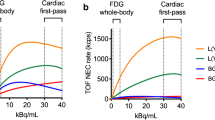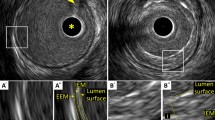Abstract
Calculation of fractional flow reserve (FFR) based on computational fluid dynamics (CFD) requires reconstruction of patient-specific coronary geometry and estimation of hyperemic flow rate. Coronary computed tomography angiography (CCTA) and invasive coronary angiography (ICA) are two dominating imaging modalities used for the geometrical reconstruction. Our aim was to investigate the impact of image resolution as inherently associated with these two imaging modalities on geometrical reconstruction and subsequent FFR calculation. Patients with mild or intermediate coronary stenoses who underwent both CCTA and ICA were included. CCTA images were acquired either by 320-row area detector CT or by 128-slice dual-source CT. Two geometrical models were reconstructed separately from CCTA and ICA, from which FFRCTA and FFRQCA were subsequently calculated using CFD simulations, applying the same hyperemic flow rate derived from the ICA images at the inlet boundaries. A total of 57 vessels in 41 patients were analyzed. Average diameter stenosis was 43.4 ± 10.8 % by 3D QCA. Reasonably good correlation between FFRCTA and FFRQCA was observed (r = 0.71, p < 0.001). The difference between FFRCTA and FFRQCA was correlated with the deviation between minimal lumen areas by CCTA and by ICA (ρ = 0.34, p = 0.01), but not with plaque volume (ρ = −0.09, p = 0.51) or calcified plaque volume (ρ = 0.01, p = 0.95). Applying the cutoff value of ≤0.8 to both FFRCTA and FFRQCA, the agreement between FFRCTA and FFRQCA in discriminating functional significant stenoses was moderate (kappa 0.47, p < 0.001). Disagreement was found in 10 (17.5 %) vessels. Acceptable correlation between FFRCTA and FFRQCA was observed, while their agreement in distinguishing functional significant stenosis was moderate. Our results suggest that image resolution has a significant impact on FFR computation.







Similar content being viewed by others
Abbreviations
- ADCT:
-
320-row area detector CT
- CCTA:
-
Coronary computed tomography angiography
- CFD:
-
Computational fluid dynamics
- DSCT:
-
128-slice dual-source CT
- FFR:
-
Fractional flow reserve
- ICA:
-
Invasive coronary angiography
- MLA:
-
Minimum lumen area
- OCT:
-
Optical coherence tomography
- QCA:
-
Quantitative coronary angiography
- VFR:
-
Volumetric flow rate
References
Pijls NH et al (2007) Percutaneous coronary intervention of functionally nonsignificant stenosis: 5-year follow-up of the DEFER Study. J Am Coll Cardiol 49(21):2105–2111
Tonino PAL et al (2009) Fractional flow reserve versus angiography for guiding percutaneous coronary intervention. N Engl J Med 360(3):213–224
De Bruyne B et al (2012) Fractional flow reserve-guided PCI versus medical therapy in stable coronary disease. N Engl J Med 367(11):991–1001
Min JK et al (2012) Diagnostic accuracy of fractional flow reserve from anatomic CT angiography. JAMA 308(12):1237–1245
Baumann S et al (2015) Coronary CT angiography-derived fractional flow reserve correlated with invasive fractional flow reserve measurements–initial experience with a novel physician-driven algorithm. Eur Radiol 25(4):1201–1207
Coenen A et al (2015) Fractional flow reserve computed from noninvasive CT angiography data: diagnostic performance of an on-site clinician-operated computational fluid dynamics algorithm. Radiology 274(3):674–683
Morris PD et al (2013) Virtual fractional flow reserve from coronary angiography: modeling the significance of coronary lesions: results from the VIRTU-1 (VIRTUal Fractional Flow Reserve From Coronary Angiography) study. JACC Cardiovasc Interv 6(2):149–157
Papafaklis MI et al (2014) Fast virtual functional assessment of intermediate coronary lesions using routine angiographic data and blood flow simulation in humans: comparison with pressure wire—fractional flow reserve. EuroIntervention 10(5):574–583
Tu S et al (2014) Fractional flow reserve calculation from 3-dimensional quantitative coronary angiography and TIMI frame count: a fast computer model to quantify the functional significance of moderately obstructed coronary arteries. JACC Cardiovasc Interv 7(7):768–777
Tu S et al (2015) Image-based assessment of fractional flow reserve. EuroIntervention 11(Suppl V):50–54
De Graaf MA et al (2013) Automatic quantification and characterization of coronary atherosclerosis with computed tomography coronary angiography: cross-correlation with intravascular ultrasound virtual histology. Int J Cardiovasc Imaging 29(5):1177–1190
Tu S et al (2012) In vivo comparison of arterial lumen dimensions assessed by co-registered three-dimensional (3D) quantitative coronary angiography, intravascular ultrasound and optical coherence tomography. Int J Cardiovasc Imaging 28(6):1315–1327
Stefanini GG, Windecker S (2015) Can coronary computed tomography angiography replace invasive angiography? Coronary computed tomography angiography cannot replace invasive angiography. Circulation 131(4):418–425 discussion 426
Hebsgaard L et al (2015) Co-registration of optical coherence tomography and X-ray angiography in percutaneous coronary intervention. The does optical coherence tomography optimize revascularization (DOCTOR) fusion study. Int J Cardiol 182:272–278
Johnson NP, Kirkeeide RL, Gould KL (2013) Coronary anatomy to predict physiology: fundamental limits. Circ Cardiovasc Imaging 6(5):817–832
Sun G et al (1016) 320-detector row CT coronary angiography: effects of heart rate and heart rate variability on image quality, diagnostic accuracy and radiation exposure. Br J Radiol 2012(85):e388–e394
Nakagawa J et al (2013) Reduction of thoracic aorta motion artifact with high-pitch 128-slice dual-source computed tomographic angiography: a historical control study. J Comput Assist Tomogr 37(5):755–759
Dehmer GJ et al (2012) A contemporary view of diagnostic cardiac catheterization and percutaneous coronary intervention in the United States: a report from the CathPCI Registry of the National Cardiovascular Data Registry, 2010 through June 2011. J Am Coll Cardiol 60(20):2017–2031
Eric KW, Poon UH, Thondapu V, Andrew SH, Ooi SM, Asrar-Ul-Haq M, Foin N, Tu S, Chin C, Monty JP, Marusic I, Barlis P (2015) Advances in three-dimensional coronary imaging and computational fluid dynamics: Is virtual fractional flow reserve more than just a pretty picture? J Coron Artery Dis. doi: 10.1097/MCA.0000000000000219 (in press)
Koo BK et al (2011) Diagnosis of ischemia-causing coronary stenoses by noninvasive fractional flow reserve computed from coronary computed tomographic angiograms. Results from the prospective multicenter DISCOVER-FLOW (Diagnosis of Ischemia-Causing Stenoses Obtained Via Noninvasive Fractional Flow Reserve) study. J Am Coll Cardiol 58(19):1989–1997
Norgaard BL et al (2014) Diagnostic performance of noninvasive fractional flow reserve derived from coronary computed tomography angiography in suspected coronary artery disease: the NXT trial (Analysis of Coronary Blood Flow Using CT Angiography: Next Steps). J Am Coll Cardiol 63(12):1145–1155
Papadopoulou SL et al (2013) Reproducibility of computed tomography angiography data analysis using semiautomated plaque quantification software: implications for the design of longitudinal studies. Int J Cardiovasc Imaging 29(5):1095–1104
Bourantas CV et al (2009) Comparison of quantitative coronary angiography with intracoronary ultrasound Can quantitative coronary angiography accurately estimate the severity of a luminal stenosis? Angiography 60(2):169–179
Tu S et al (2011) The impact of acquisition angle differences on three-dimensional quantitative coronary angiography. Catheter Cardiovasc Interv 78(2):214–222
Li Y et al (2015) Impact of side branch modeling on computation of endothelial shear stress in coronary artery disease coronary tree reconstruction by fusion of 3D angiography and OCT. J Am Coll Cardiol 66(2):125–135
Acknowledgments
This work was supported in part by the Natural Science Foundation of China under Grant 31500797 and 81501467. Shengxian Tu would also like to acknowledge the support by the Program for Professor of Special Appointment (Eastern Scholar) at Shanghai Institutions of Higher Learning and by Shanghai Pujiang Program (No. 15PJ1404200).
Author information
Authors and Affiliations
Corresponding author
Ethics declarations
Conflict of interest
Y. Li and P. Kitslaar are employed by Medis medical imaging systems bv and have a research appointment at the Leiden University Medical Center (LUMC). J. H. C. Reiber is the CEO of Medis, and has a part-time appointment at LUMC as Prof. of Medical Imaging. S. Tu receives research grant support from Medis. All other authors declare that they have no conflict of interest.
Additional information
Lili Liu and Wenjie Yang have contributed equally to this work.
Rights and permissions
About this article
Cite this article
Liu, L., Yang, W., Nagahara, Y. et al. The impact of image resolution on computation of fractional flow reserve: coronary computed tomography angiography versus 3-dimensional quantitative coronary angiography. Int J Cardiovasc Imaging 32, 513–523 (2016). https://doi.org/10.1007/s10554-015-0797-5
Received:
Accepted:
Published:
Issue Date:
DOI: https://doi.org/10.1007/s10554-015-0797-5




